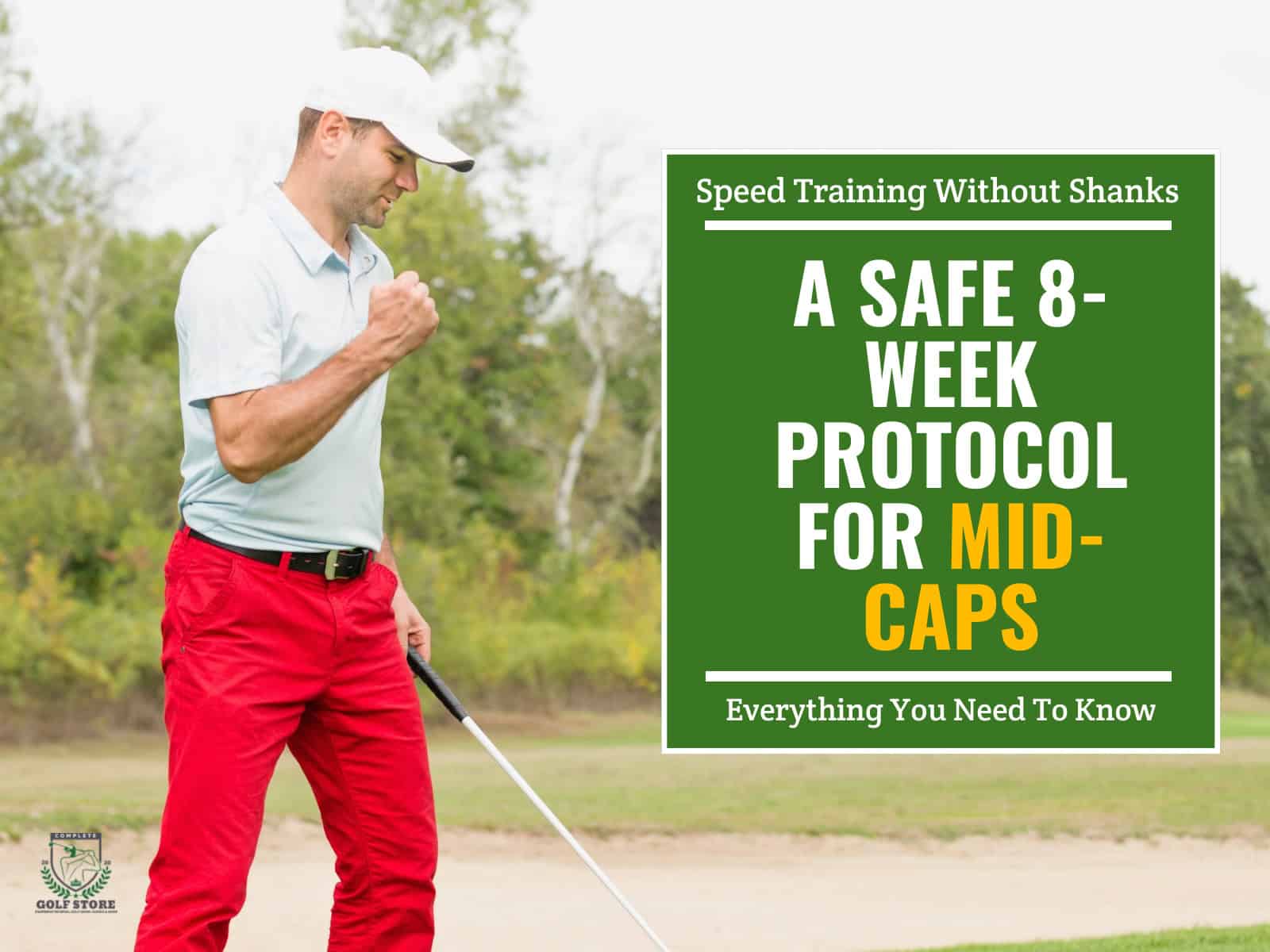The flop or lob shot is perfect for getting over obstacles or stopping the ball quickly. It requires skill, precision, and a bit of finesse, and can help you get out of tricky situations and onto the green with ease.
However, hitting a flop shot can be tricky and intimidating for beginners. That’s why, in this article, I’ll share with you some tips and techniques on how to hit a flop shot. From choosing the right club to the proper setup and execution, I’ll cover everything you need to know to pull off this shot with confidence.
So grab your wedge and let’s get started on perfecting your flop shot!
- 1) What is a Flop Shot?
- 2) Why You Need A Flop Shot
- 3) How to Hit a Flop Shot Step By Step
- 4) How Does a Flop Shot Differ from a Pitch or Chip?
- 5) Reading the Lie for A Successful Flop Shot
- 6) Can You Hit Flop Shots from Any Lie?
- 7) What Equipment Is Best for The Flop Shot?
- 8) When To Use Your Flop Shot?
- 9) Final Thoughts
What is a Flop Shot?
A flop shot is a high trajectory, soft landing shot that falls into the short game category of golf.
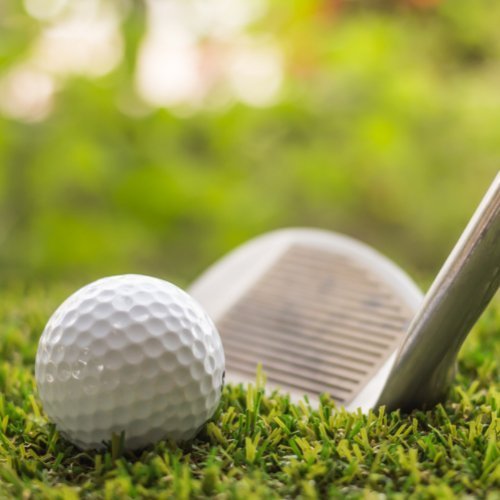
It is a type of shot that is designed to spin the ball and stop it quickly. The flop shot is an important tool for golfers, especially in tricky situations where the ball needs to be stopped quickly and with minimal roll.
The basic goal of a flop shot is to get the ball up in the air quickly with a high degree of loft so that it lands softly on the green without rolling too far. This shot is achieved by using a lob wedge or a sand wedge with a high degree of loft, and the key to making the shot is in the setup position and proper technique.
Why You Need A Flop Shot
Having a successful flop shot in your arsenal can be a game-changer in many tricky situations. A flop shot allows your ball to have minimal roll and gives you the ability to clear obstacles like bunkers or roughs and land softly on the green. To execute a flop shot, you will need a lob wedge with a high degree of loft.
The ability to hit different short-game shots like the flop shot is what separates single-digit handicap golfers from amateurs.
How to Hit a Flop Shot Step By Step
Hitting a flop shot is a high-risk, high-reward shot that requires precise contact with the ball if you want to achieve optimal results. To execute this shot successfully, there are several key elements that must be taken into account: Here’s how to hit a successful lob shot:
Pick The Correct Club
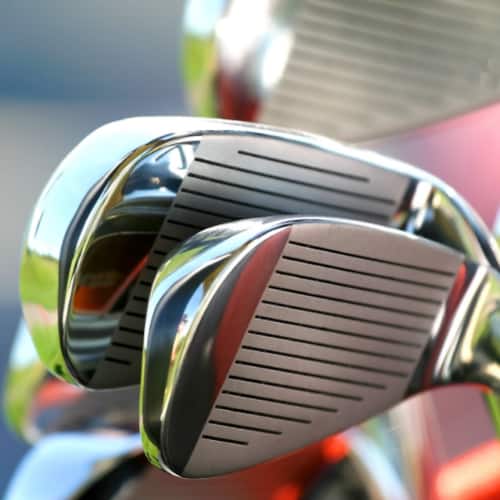
Wedges with higher lofts are ideal for hitting flop shots.
The lob wedge is specifically designed for such shots, with lofts ranging from 58 to 64 degrees. A sand wedge, with a loft of around 54 degrees, can also be used for a flop shot. However, it may not offer as much loft as a lob wedge, making the shot more challenging.
Selecting the right club is essential because it determines the angle of attack, clubhead speed, and resultant trajectory of the shot.
A lofted club allows the ball to go high in the air with minimal roll. At the same time, selecting the wrong club can result in a bladed shot or a severe mishit, leading to bad results.
Visualize the Shot
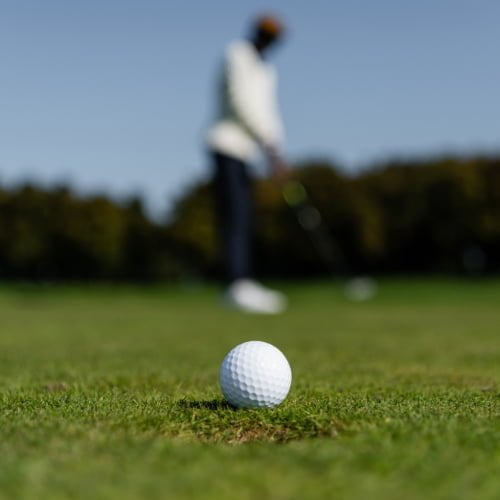
Start by visualizing the trajectory of the ball, the landing spot on the green, and the length of swing necessary to execute the shot. This mental preparation is crucial in the pre-shot routine as it helps establish a clear vision of the shot you intend to hit.
When visualizing the shot, be sure to pick a specific target to land the ball. This target may be a smaller area on the green that is easier to hit. Focusing on a smaller target creates a sense of precision and reduces the chance of missing the shot. Additionally, determining the length of swing needed to reach the target is crucial. A shorter swing will result in a higher shot while a longer swing will produce more distance.
As you approach the ball, keep your visualization of the intended flight plan and landing spot in your mind. Just before hitting the shot, imagine the ball hitting the target and rolling out within kick-in distance to the hole. This will help build confidence in executing the shot correctly.
Flop Shot Ball Position
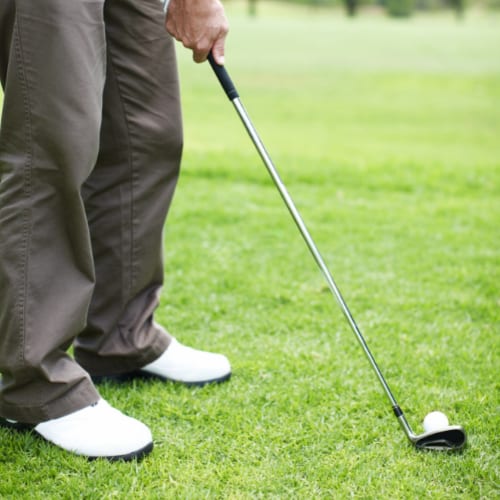
The correct ball position allows for a clean and crisp strike of the ball. For a flop shot, the ball should be positioned forward of center in your stance. The higher the desired shot, the more forward in the stance it should be.
Having the ball in the wrong position can lead to undesired consequences. If the ball is too far back in your stance, you’ll risk hitting a bladed shot with minimal loft, leading to additional shots to get on the green. On the other hand, if the ball is too far forward in your stance, you’ll have a difficult time hitting down on the ball, leading to a steep angle of attack and a shot that travels too low.
Open the Clubface & Stance
For the perfect flop shot, you need to open the clubface and stance. You can execute the following technique to achieve the desired result.
- Select a high-lofted wedge: Choose a club that has a loft of at least 56 degrees. This will help you get plenty of height and minimal roll when hitting the ball.
- Open the clubface: To get under the ball and launch it high into the air, you need to position the clubface open. This involves turning the clubface to the right of the target slightly (for a right-handed golfer).
- Aim left: Align your body and feet left of the target in order to create a swing angle that will allow the ball to lift into the air and land softly. Note that opening the clubface should give you some extra width to the left of the desired target.
- Maintain wrist cupping: Keep the cup in your left wrist throughout the swing, and make sure not to release that cup. This will allow you to control the clubface and strike the ball cleanly, providing plenty of loft and spin.
- Point the clubface at your target: At the top of your backswing, make sure that you’re angling the clubhead straight at your intended target.
Shift Your Weight and Wrists
It is essential to shift your weight and use your wrists properly. Some steps to follow for a right-handed player include the following:
- Set your wrists at address: At the setup position, ensure that your wrist is set for a flop shot. Your right wrist should be flat, and your left wrist slightly cupped.
- Shift your weight onto your front foot: To create a steep attack angle, shift your weight onto your front foot, with 70% of your weight on your left leg.
- Maintain a longer swing: A longer swing helps to generate more clubhead speed required for the ball to travel high in the air with minimal roll. Focus on creating a longer backswing by rotating your body and extending your arms fully.
- Time your release: A well-timed release is crucial for executing a successful flop shot. Aim to release your wrists at impact, and avoid any forward press or wrist movement during the takeaway.
- Keep your body quiet: Throughout the swing, it is essential to keep your body still and quiet. Your upper body should remain centered, and your legs should not move excessively.
By following these steps and maintaining proper weight shift and wrist action, you can execute a perfect flop shot. Practice this technique to gain more confidence around the greens and improve your performance.
Perfecting the Flop Shot Swing
To perfect the flop shot and conquer difficult situations around the green, you need to master a few techniques. First, aim for an outside-to-inside swing path, lining up your feet and keeping the clubface open as you swing down to impact. Here are some tips:
- Keep your body and club moving along the same outside-to-inside path through the shot.
- Ensure that the clubface stays open to the path through impact.
- Let the club slide under the ball as you swing through the shot.
- As you swing through the ball, turn your body toward the target in the follow-through.
- Focus on accelerating through the shot, putting extra power in the clubhead slide.
Mistakes to avoid include a steep swing that moves too far inside-out, a bladed shot with too little loft, or a poorly-angled impact that causes too much roll.
Practice the Lob Shot Consistently
Consistent practice will help you fine-tune your technique. Start by experimenting with different angles, distances, and lies. This will allow you to get comfortable with the many variables that can affect the shot.
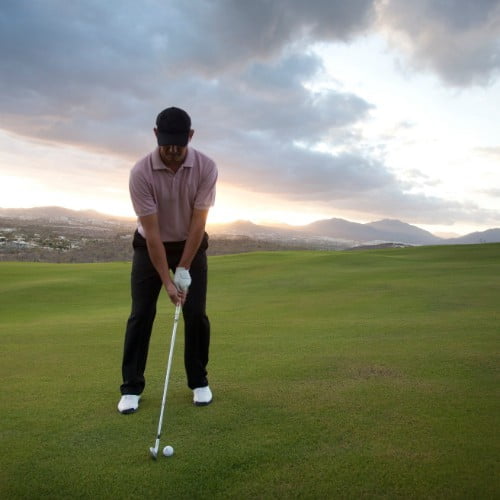
Practicing the flop shot regularly will build the confidence and trust needed to successfully execute the shot on the course. Take advantage of your practice sessions to hit as many flop shots as possible. Through repetition, you can improve the consistency and control of your lofted shots, minimizing the risk of a bladed or poorly executed shot.
Additional Tips
Accelerating through impact is critical to executing the perfect flop shot. Make sure your club head speed is constant through your impact point. Avoid flipping your wrists which can cause bladed shots. Instead, maintain a firm left wrist and keep your body quiet through the shot, letting the lofted club do the work. This will help generate more spin.
When practicing your flop shot, hit balls from different lies, angles, and distances. Set up a narrow target to aim for. Practice it until you feel confident to use it on the course. It’s a difficult shot to consistently execute, so practice it often.
How Does a Flop Shot Differ from a Pitch or Chip?
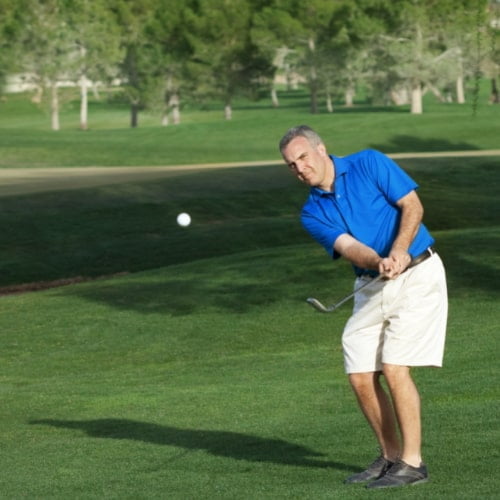
It is important to understand the difference between a flop shot, pitch, and chip. These shots require different techniques, clubs, and distances to execute successfully.
These are the key differences:
- Flop shot: A flop shot is a high trajectory shot that is used to hit over an obstacle, such as a bunker or a tree, and land softly on the green with minimal roll. This shot is usually performed 10 to 30 yards from the green and requires a lob wedge with a high degree of loft, typically around 60 degrees, to get the ball in the air quickly. The ideal clubhead speed for a flop shot is around 60-70 miles per hour, and the ball should be positioned forward in your stance with your lower body quiet.
- Pitch shot: A pitch shot is a medium trajectory shot that is used to hit the ball onto the green with some roll (usually 20-50 yards from the green). This shot requires a pitching wedge with a moderate degree of loft, typically around 48-52 degrees, to get the ball high enough to carry over a hazard and land softly on the green. The ideal clubhead speed for a pitch shot is around 50-60 miles per hour, and the ball should be positioned in the middle of your stance with a slight weight shift to your front foot.
- Chip shot: A chip shot is a low trajectory shot that is used to hit the ball onto the green and let it roll toward the hole. This shot is usually within 10 yards from the green and requires a sand wedge or a pitching wedge with a low degree of loft, typically around 35-45 degrees, to get the ball rolling quickly on the green. The ideal clubhead speed for a chip shot is around 30-40 miles per hour, and the ball should be positioned back in your stance with your hands ahead of the ball.
By understanding the differences between these shots and their respective techniques, you can improve your game and make more informed decisions on the course.
Reading the Lie for A Successful Flop Shot
It’s important to read the lie to determine if a flop shot is an appropriate shot to play. You can follow some tips to do so:
- Consider the length and thickness of the grass: If the grass is long and thick, it’s a good indication that a flop shot may be effective. The longer grass will allow the clubface to slide under the ball, promoting backspin.
- Be cautious of tight lies: These are lies where the ball is sitting on short grass and there is very little room for the clubface to slide under the ball. This increases the risk of blading the shot, which can lead to a poor result.
- Take note of buried balls: In this case, a flop shot may not be the best option. Instead, you may need to use a bunker shot technique to get the ball out of the rough.
By carefully reading the lie and taking into account the grass length, thickness, and any obstacles, you can make an informed decision on whether a flop shot is the appropriate shot to play.
Can You Hit Flop Shots from Any Lie?
While it is technically possible to attempt a flop shot from any lie, it is not always the most practical or advisable shot selection.
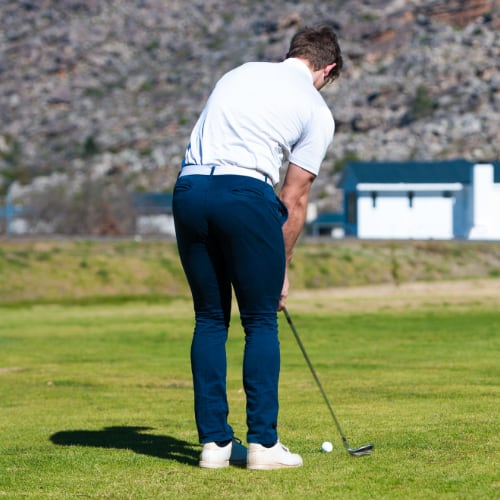
To assess whether a lie is suitable for a flop shot, determine the grass length and consistency of the ground. If the ground is hard and the grass is short, the lie may not be suitable for a flop shot. However, if the grass is thicker and softer, it’s an excellent opportunity to execute a successful flop.
The following are examples of lies that might not be the best for lob shots:
- Fairway Lie: It is generally more challenging to execute a flop shot from a tight, closely-mown fairway lie. The thin contact and high loft required for a flop shot make it difficult to consistently strike the ball cleanly from a tight lie. In such situations, a pitch or chip shot might be more appropriate.
- Rough: Hitting a flop shot from thick rough can be risky. The longer grass can interfere with clean contact between the clubface and the ball, leading to inconsistent strikes or potential mis-hits. The ball might not pop up as high as intended, potentially resulting in a poor outcome. In these cases, it’s often better to choose a shot with less loft, like a pitch or a chip, which can help control the trajectory and offer more reliable results.
- Bunker: Flop shots from greenside bunkers can be effective when there’s a significant lip or a short distance to carry the ball. However, the sand’s consistency and the presence of a high lip can make it challenging to execute a successful flop shot. In bunkers, it’s generally more common to use a standard explosion shot or a greenside bunker shot technique, which focuses on getting the ball out and onto the green rather than hitting a high, soft shot.
With that said, let’s have a look at video (3 min. 15 sec.) where the master of flop shots- Phil Mickelson shows how to perform flop shots from different lies:
Here is another video from the PGA Tour Youtube channel (3 min. 36 sec.) compiling Phil Mickelson’s best flop shots throughout his career; he even performs a reverse flop shot:
What Equipment Is Best for The Flop Shot?
When choosing a wedge, it’s important to consider the type of lie you’re facing. A lob wedge with a high degree of loft, typically between 58-60 degrees, is ideal for shots around the green. However, the wedge’s bounce and grind are equally important in achieving loft and preventing the club from digging into the ground.
Club bounce refers to the angle between the leading edge and the trailing edge of the club’s sole. For flop shots, having a wedge with higher bounce can be beneficial. The additional bounce helps the club glide through the grass or sand, preventing it from digging too deeply and promoting clean contact with the ball. Bounce also provides a margin of error, reducing the likelihood of the clubhead digging into the ground or causing a fat shot.
Grind refers to the shaping and contouring of the sole of the wedge. Different grind options affect how the wedge interacts with the turf and sand. For flop shots, a wedge with a versatile grind or a higher bounce can be advantageous. It allows for more versatility in opening up the clubface while maintaining proper bounce and leading edge contact with the ground.
Testing different wedge configurations in practice sessions will help determine which works best for the conditions you face.
When To Use Your Flop Shot?

You should only attempt a flop shot when it’s absolutely necessary and when no other shot is possible. These are examples of when flops can be attempted:
- When there are high obstacles, such as a bunker, rough, or a steep lip, between your ball and the green.
- When the pin is located close to the edge of the green with very little green to work with. hitting a high, soft shot, you can stop the ball quickly and control the landing spot more precisely.
- While the flop shot is generally not recommended from tight lies on the fairway, there may be occasions where you need to hit a high shot over a hazard or obstacle from a tight lie.
- When greens are fast and firm, the soft landing of a flop shot helps prevent the ball from bounding or rolling excessively upon landing.
- In situations where you find yourself in a difficult position or facing a challenging lie around the green, a well-executed flop shot can help you recover and get back into play. It can help you loft the ball up and over hazards, slopes, or difficult lies to advance it toward the green.
Final Thoughts
Hitting a lob shot can be a valuable shot in difficult situations, but it comes with risks. It requires precision and practice. You should only use it when necessary, as the margin for error is minimal.
We covered the topic in detail throughout this guide to help you perfect your technique and boost confidence to hit successful flop shots whenever needed.
But, remember, the flop shot is just one technique among many others you should know to truly excel in golf. For instance, learning how to hit a draw can further improve your performance and make you an all-rounded golfer. Practice consistently, and don’t be afraid to experiment with different types of shots.
Feel free to leave a comment if you have any questions or insights related to the flop shot.
Good luck!





